Chinese online store from the inside
We are in a hotel room in the city of Shenzhen (shame on me, in two days I did not learn to pronounce it correctly - I constantly confuse the first and last parts, it turns out that I’m writing. And I write the same).
It is already evening, and you need to go to bed - tomorrow you have to get up at 7 o'clock, and by 8 to be in the office - the working day will begin.
From our hotel, go about 40 minutes by bus. The subway would be faster, but longer to get from the nearest station.
We are waiting for the bus:
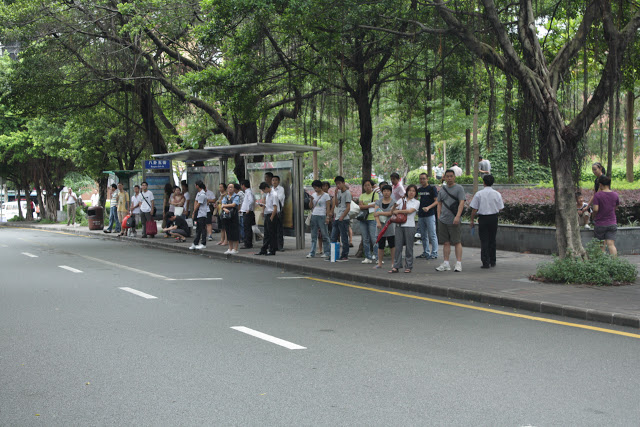
Most accurately in terms of tourism, the city is described in this dialogue:
What can be seen in Shenzhen and its surroundings?
-In the vicinity of Shenzhen you can see Hong Kong.
The city is young and not very remarkable for tourists (unless, of course, you are not interested in huge electronics markets). However, it is interesting to others - in 30 years the city has managed to make the way from a fishing village to almost the fastest growing (economically) city in the world.
')
Apart from this, this is a typical Chinese city. A lot of people, a lot of bikes, and a lot of greenery. Very humid and very hot - almost tropics (Wikipedia suggests that it is subtropics). Shops with modern electronics and high skyscrapers side by side with small houses and things, drying on the fences.
Hong Kong is an hour away from us, but we will not go there - we have a plane from Shenzhen Bao'an, and for returning from Hong Kong we need a double-entry visa.
Immediately, in the city center are the main offices of the most, perhaps, well-known Chinese companies producing mobile phones - ZTE and Huawei.
ZTE office (high shit):

And the Huawei office (one-in-one hotel building in the middle of the park):
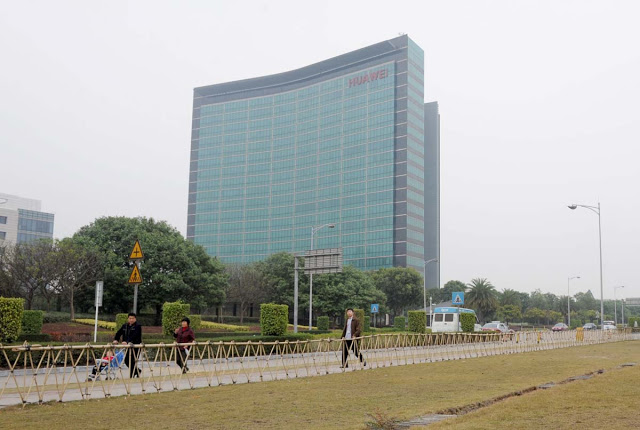
Photos are not mine, but shamelessly copied from the Internet.
Their warehouses are located just outside the city, an hour away (or half an hour by subway) in the direction opposite to Hong Kong. Unfortunately, we will not go there today - their phones and tablets are still in stock. There is also Foxconn headquarters here, but go even further.
The working day starts at 8 am, at this time all employees must be in the workplace. We arrived at 7.55. There are traditionally a lot of work since morning on weekdays - the evening at mid-Moscow time has just ended, and the store is full of orders. And YouTube is not working here.
Entrance to the building where the office is located:
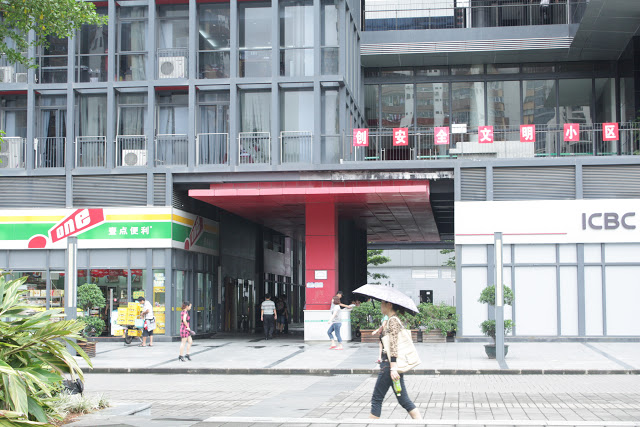
Overnight, only 87 orders have accumulated - summer, they buy little. Some of this is already in stock, and it remains only to pack, for something you need to go to the manufacturer's warehouse, and the rest can be sent only tomorrow - when the car comes from another city.

All 12 people who work now are already in their places. The manager and the accountant in the morning on the phones, the logistics man sits at the computer - today go to the warehouse.
Two webmasters have not been seen for a week - a lot of work, launching the Russian version of the site.
The remaining five are regional managers. Two people work in the US and European markets, and three in the Russian (if translated into Russian, what they do will be something like a development manager, a support employee and a website translator). And of course the most important is Wang Yi, he is the most important here.
I even manage to catch the assembly of one of the parcels:
Specially trained Chinese, checking with a piece of paper-a copy of the order, looking at the warehouse (here it is small. It makes no sense to pay for a large warehouse, when to the farthest warehouse of the manufacturer - an hour drive) goods.
Then he wraps it up with a foil wrap (there is a whole roll of it!):
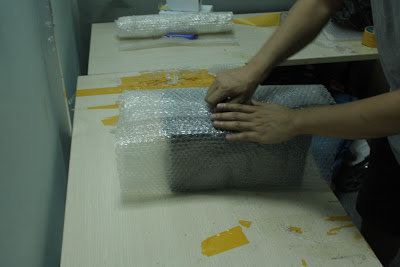
And pastes over two layers of tape:

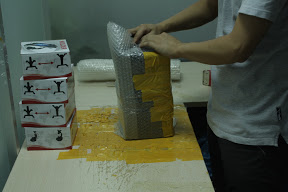
Everything is done by hand, not even a scotch dispenser is used.
Then they stick a track number and information for customs:


The next time, tearing such a package, remember that behind this is the work of an unnamed Chinese (in our case, not anonymous. His name is Yang Dan and he loves cartoons).
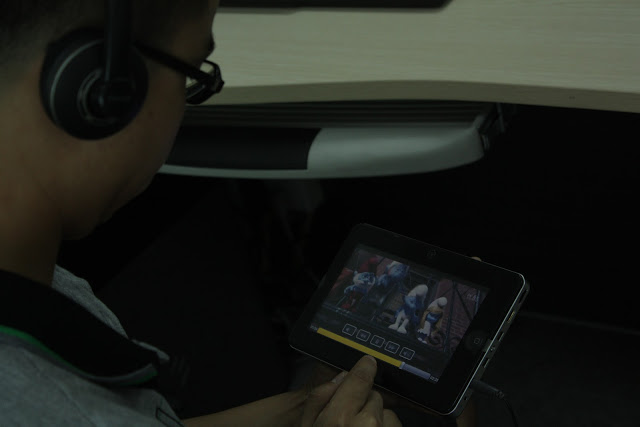
Packed parcels are put together in such piles:
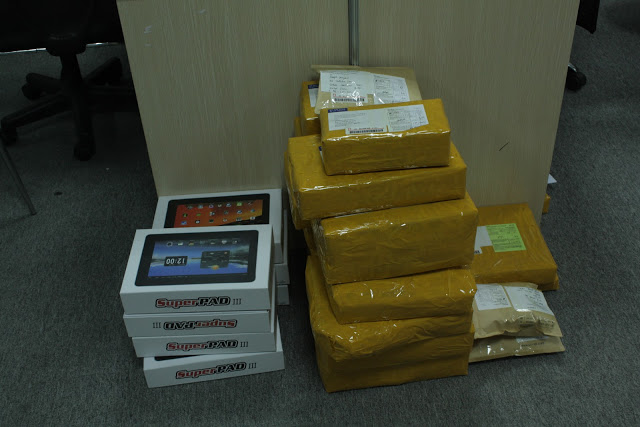
Which at the end of the day can occupy half the room. This happens most often in the winter - on New Year's holidays there is a peak in sales, up to 500 orders per day.
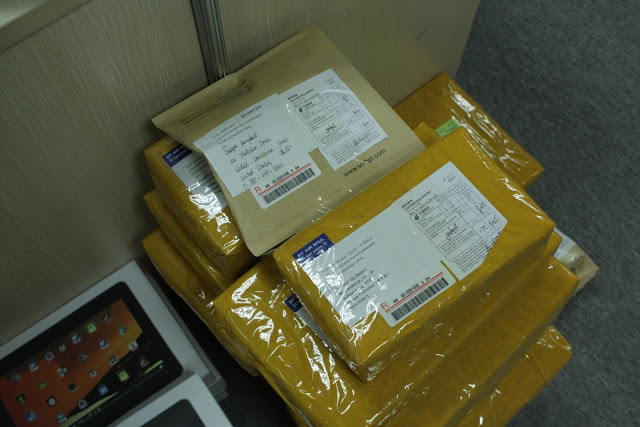
A small parcel with a track (less than 100g with packaging) sent to the Russian Federation costs $ 2. 500 grams - already $ 10. Calculated with the mail at the end of the month, non-cash by itself.
A separate stack is the shipment of EMS, DHL, and UPS:
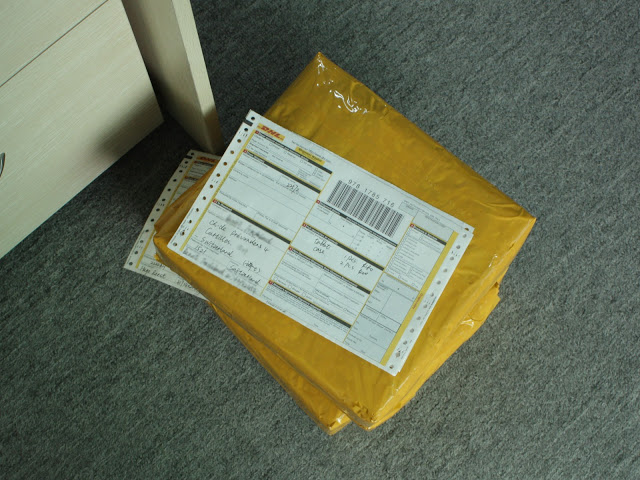
By the way, the departure of all three transport companies in Shenzhen is handled by one office. It is then that their paths diverge, obeying unknown laws of logistics.
At the end of the day, a person arrives (or rather arrives) from the post office, and carries away (more precisely, takes away) the parcels accumulated during the day:

Sometimes, you have to come (or rather come) several times:
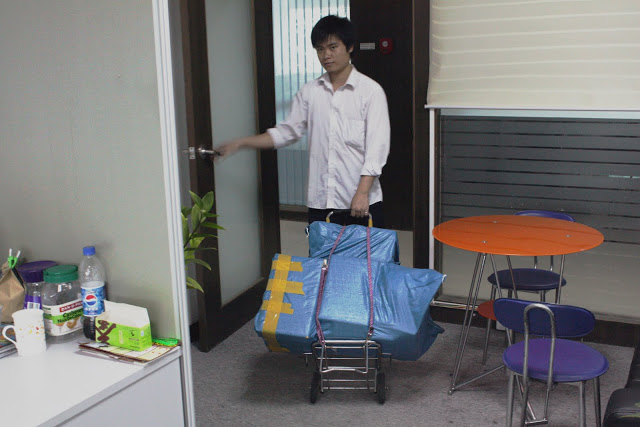
But something I digress. Now, according to the plan, lunch, and after lunch we will go to the warehouse.
Building outside:
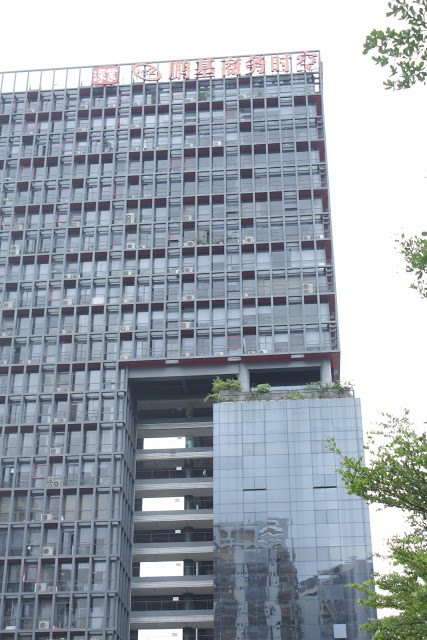
We are on the 20th floor. Unfortunately, the windows do not go to remove the top view.
Here is a business Chinese in a hurry for lunch:

But what we dined.
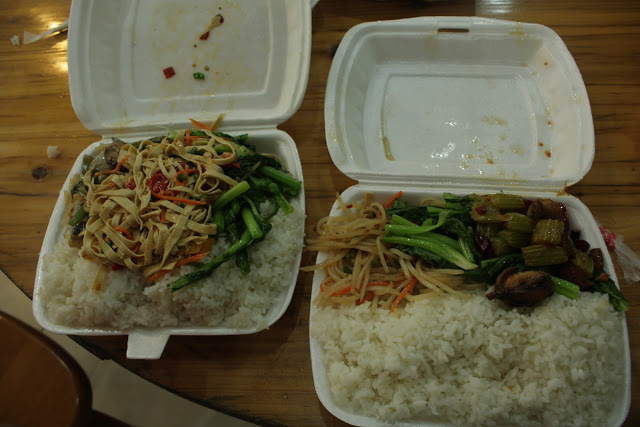
ABOUT! We are already waiting for the car.
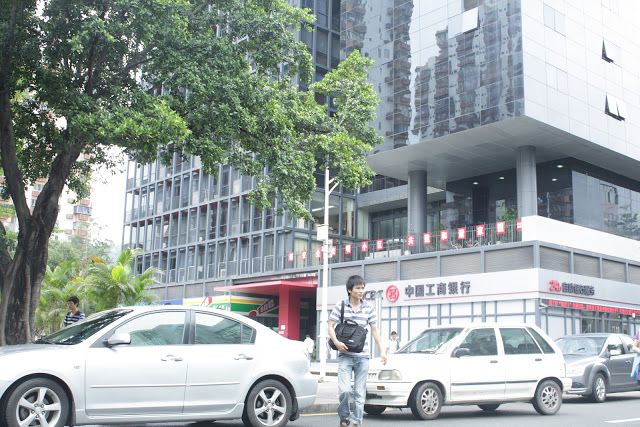
We drove very little - 10 minutes.
Our party is ready and packed:

It remains to immerse:

From the outside you can not guess what is in these boxes. Whether tablets for half a million, or frozen dumplings.

And drag it into the car:

Already raised to the 20th floor:

It remains to unpack, count, part of the check and send, and part of the throw in the warehouse until tomorrow. And we will go to the hotel - in the morning the plane.
And finally, the most delicious:

PS: photos can be viewed here: picasaweb.google.com/118217604724203015211
PPS: The site of the store went. I'm not on purpose.
It is already evening, and you need to go to bed - tomorrow you have to get up at 7 o'clock, and by 8 to be in the office - the working day will begin.
From our hotel, go about 40 minutes by bus. The subway would be faster, but longer to get from the nearest station.
We are waiting for the bus:

Most accurately in terms of tourism, the city is described in this dialogue:
What can be seen in Shenzhen and its surroundings?
-In the vicinity of Shenzhen you can see Hong Kong.
The city is young and not very remarkable for tourists (unless, of course, you are not interested in huge electronics markets). However, it is interesting to others - in 30 years the city has managed to make the way from a fishing village to almost the fastest growing (economically) city in the world.
')
Apart from this, this is a typical Chinese city. A lot of people, a lot of bikes, and a lot of greenery. Very humid and very hot - almost tropics (Wikipedia suggests that it is subtropics). Shops with modern electronics and high skyscrapers side by side with small houses and things, drying on the fences.
Hong Kong is an hour away from us, but we will not go there - we have a plane from Shenzhen Bao'an, and for returning from Hong Kong we need a double-entry visa.
Immediately, in the city center are the main offices of the most, perhaps, well-known Chinese companies producing mobile phones - ZTE and Huawei.
ZTE office (high shit):

And the Huawei office (one-in-one hotel building in the middle of the park):

Photos are not mine, but shamelessly copied from the Internet.
Their warehouses are located just outside the city, an hour away (or half an hour by subway) in the direction opposite to Hong Kong. Unfortunately, we will not go there today - their phones and tablets are still in stock. There is also Foxconn headquarters here, but go even further.
The working day starts at 8 am, at this time all employees must be in the workplace. We arrived at 7.55. There are traditionally a lot of work since morning on weekdays - the evening at mid-Moscow time has just ended, and the store is full of orders. And YouTube is not working here.
Entrance to the building where the office is located:

Overnight, only 87 orders have accumulated - summer, they buy little. Some of this is already in stock, and it remains only to pack, for something you need to go to the manufacturer's warehouse, and the rest can be sent only tomorrow - when the car comes from another city.

All 12 people who work now are already in their places. The manager and the accountant in the morning on the phones, the logistics man sits at the computer - today go to the warehouse.
Two webmasters have not been seen for a week - a lot of work, launching the Russian version of the site.
The remaining five are regional managers. Two people work in the US and European markets, and three in the Russian (if translated into Russian, what they do will be something like a development manager, a support employee and a website translator). And of course the most important is Wang Yi, he is the most important here.
I even manage to catch the assembly of one of the parcels:
Specially trained Chinese, checking with a piece of paper-a copy of the order, looking at the warehouse (here it is small. It makes no sense to pay for a large warehouse, when to the farthest warehouse of the manufacturer - an hour drive) goods.
Then he wraps it up with a foil wrap (there is a whole roll of it!):

And pastes over two layers of tape:


Everything is done by hand, not even a scotch dispenser is used.
Then they stick a track number and information for customs:


The next time, tearing such a package, remember that behind this is the work of an unnamed Chinese (in our case, not anonymous. His name is Yang Dan and he loves cartoons).

Packed parcels are put together in such piles:

Which at the end of the day can occupy half the room. This happens most often in the winter - on New Year's holidays there is a peak in sales, up to 500 orders per day.

A small parcel with a track (less than 100g with packaging) sent to the Russian Federation costs $ 2. 500 grams - already $ 10. Calculated with the mail at the end of the month, non-cash by itself.
A separate stack is the shipment of EMS, DHL, and UPS:

By the way, the departure of all three transport companies in Shenzhen is handled by one office. It is then that their paths diverge, obeying unknown laws of logistics.
At the end of the day, a person arrives (or rather arrives) from the post office, and carries away (more precisely, takes away) the parcels accumulated during the day:

Sometimes, you have to come (or rather come) several times:

But something I digress. Now, according to the plan, lunch, and after lunch we will go to the warehouse.
Building outside:

We are on the 20th floor. Unfortunately, the windows do not go to remove the top view.
Here is a business Chinese in a hurry for lunch:

But what we dined.

ABOUT! We are already waiting for the car.

We drove very little - 10 minutes.
Our party is ready and packed:

It remains to immerse:

From the outside you can not guess what is in these boxes. Whether tablets for half a million, or frozen dumplings.

And drag it into the car:

Already raised to the 20th floor:

It remains to unpack, count, part of the check and send, and part of the throw in the warehouse until tomorrow. And we will go to the hotel - in the morning the plane.
And finally, the most delicious:

PS: photos can be viewed here: picasaweb.google.com/118217604724203015211
PPS: The site of the store went. I'm not on purpose.
Source: https://habr.com/ru/post/126442/
All Articles